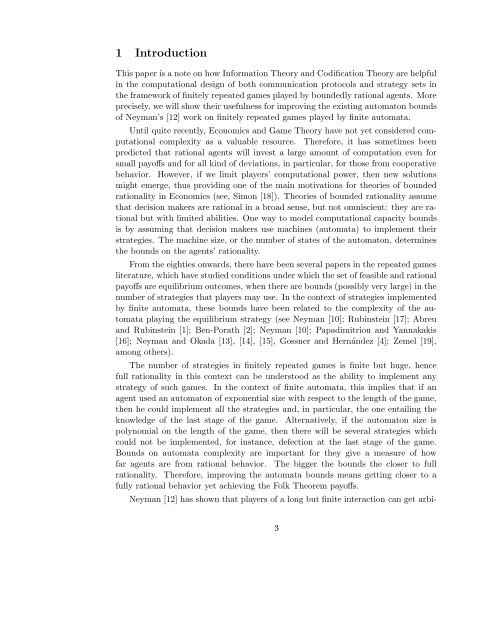CODIFICATION SCHEMES AND FINITE AUTOMATA ... - Ivie
Create successful ePaper yourself
Turn your PDF publications into a flip-book with our unique Google optimized e-Paper software.
1 Introduction<br />
This paper is a note on how Information Theory and Codification Theory are helpful<br />
in the computational design of both communication protocols and strategy sets in<br />
the framework of finitely repeated games played by boundedly rational agents. More<br />
precisely, we will show their usefulness for improving the existing automaton bounds<br />
of Neyman’s [12] work on finitely repeated games played by finite automata.<br />
Until quite recently, Economics and Game Theory have not yet considered computational<br />
complexity as a valuable resource. Therefore, it has sometimes been<br />
predicted that rational agents will invest a large amount of computation even for<br />
small payoffs and for all kind of deviations, in particular, for those from cooperative<br />
behavior. However, if we limit players’ computational power, then new solutions<br />
might emerge, thus providing one of the main motivations for theories of bounded<br />
rationality in Economics (see, Simon [18]). Theories of bounded rationality assume<br />
that decision makers are rational in a broad sense, but not omniscient: they are rational<br />
but with limited abilities. One way to model computational capacity bounds<br />
is by assuming that decision makers use machines (automata) to implement their<br />
strategies. The machine size, or the number of states of the automaton, determines<br />
the bounds on the agents’ rationality.<br />
From the eighties onwards, there have been several papers in the repeated games<br />
literature, which have studied conditions under which the set of feasible and rational<br />
payoffs are equilibrium outcomes, when there are bounds (possibly very large) in the<br />
number of strategies that players may use. In the context of strategies implemented<br />
by finite automata, these bounds have been related to the complexity of the automata<br />
playing the equilibrium strategy (see Neyman [10]; Rubinstein [17]; Abreu<br />
and Rubinstein [1]; Ben-Porath [2]; Neyman [10]; Papadimitriou and Yannakakis<br />
[16]; Neyman and Okada [13], [14], [15], Gossner and Hernández [4]; Zemel [19],<br />
among others).<br />
The number of strategies in finitely repeated games is finite but huge, hence<br />
full rationality in this context can be understood as the ability to implement any<br />
strategy of such games. In the context of finite automata, this implies that if an<br />
agent used an automaton of exponential size with respect to the length of the game,<br />
then he could implement all the strategies and, in particular, the one entailing the<br />
knowledge of the last stage of the game. Alternatively, if the automaton size is<br />
polynomial on the length of the game, then there will be several strategies which<br />
could not be implemented, for instance, defection at the last stage of the game.<br />
Bounds on automata complexity are important for they give a measure of how<br />
far agents are from rational behavior. The bigger the bounds the closer to full<br />
rationality. Therefore, improving the automata bounds means getting closer to a<br />
fully rational behavior yet achieving the Folk Theorem payoffs.<br />
Neyman [12] has shown that players of a long but finite interaction can get arbi-<br />
2

















